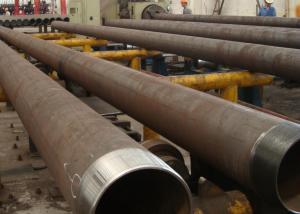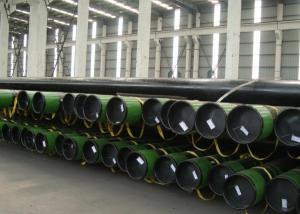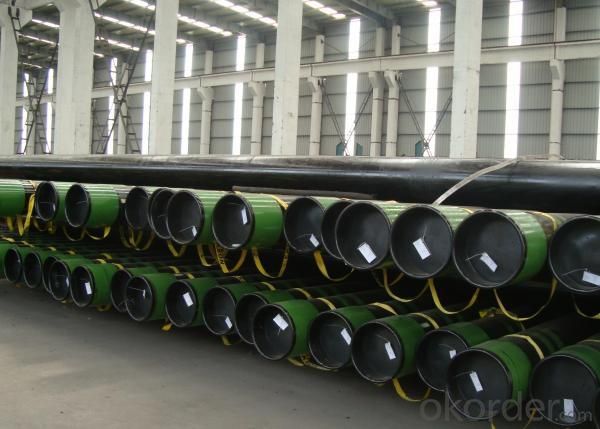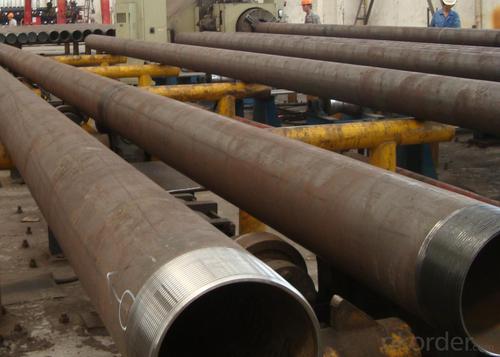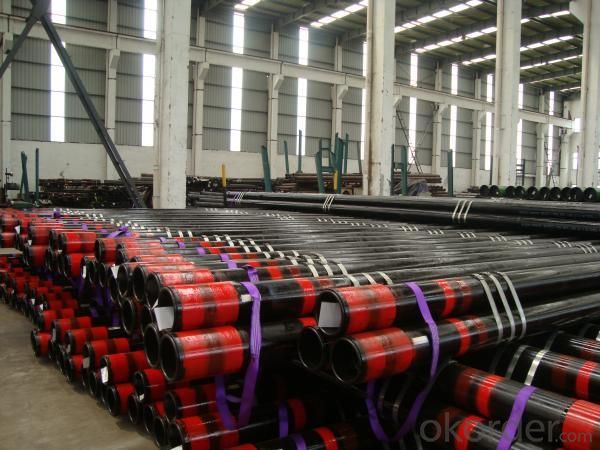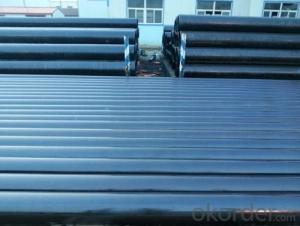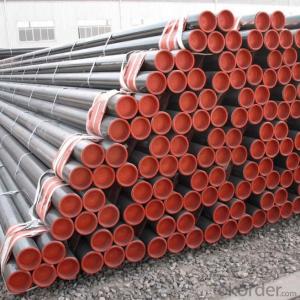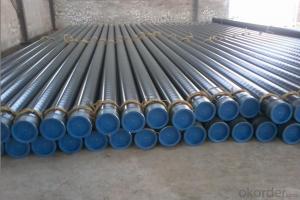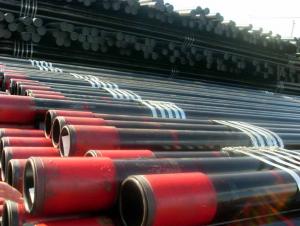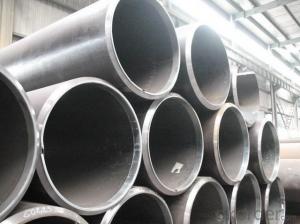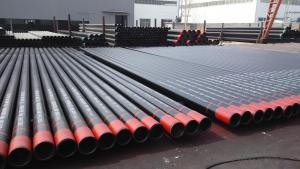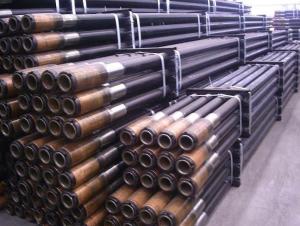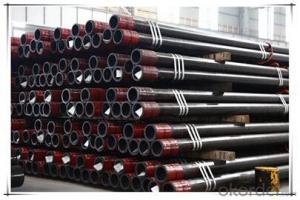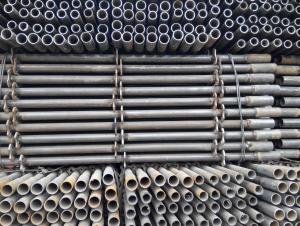BS 1387 Oil Casing and Casing Pipe APL SPEC 5CT Low Tolerance Best Quality BS Standard
- Loading Port:
- China Main Port
- Payment Terms:
- TT or LC
- Min Order Qty:
- 25 M.T. m.t.
- Supply Capability:
- 5000 Tons Per Month m.t./month
OKorder Service Pledge
OKorder Financial Service
You Might Also Like
Standard: APL SPEC 5CT
Tolerance
Item | Tolerance | |
Outside Diameter |
Pipe Body | D≤101.60mm±0.79mm |
D≥114.30mm +1.0%D-.5%D | ||
coupling | ±1%D | |
Wall Thickness | 0,-12.5%t | |
Weight | Single Lengths | +6.5%-3.5% |
Carload Lots | 0,-1.75% | |
Length
| (Range 1) | (Pange 2) | (Pange 3) |
Tubing | 6.10-7.32m | 8.53-9.75m | 11.58-12.80m |
Casing | 4.88-7.62m | 7.62-10.36m | 10.36-14.63m |
Pup Joint | 0.5m-6.0m(2FEET-20FEET) | ||
Mechanical Properties:
Group | Grade | Yield Strength | Tensile Strength | Hardness | Allowable Hardness Variation | |||||
min | max | min | max | |||||||
Psi | Mpa | Psi | Mpa | Psi | Mpa | HRC | BHN | HRC | ||
1 | J55 | 55,000 | 379 | 80,000 | 552 | 75,000 | 517 | - | - | - |
K55 | 55,000 | 379 | 80,000 | 552 | 95,000 | 655 | - | - | - | |
N80-1 | 80,000 | 552 | 80,000 | 758 | 100,000 | 689 | - | - | - | |
N80Q | 80,000 | 552 | 80,000 | 758 | 100,000 | 689 |
|
| - | |
2 | M65 | 65,000 | 448 | 85,000 | 586 | 85,000 | 586 | 22 | 235 | - |
L80-1 | 80,000 | 552 | 95,000 | 655 | 95,000 | 655 | 23 | 241 | - | |
C90-1 | 90,000 | 621 | 105,000 | 724 | 100,000 | 689 | 25.4 | 255 | 3.0 | |
C90-2 | 90,000 | 621 | 105,000 | 724 | 100,000 | 689 | 25.4 | 255 | 3.0 | |
C95 | 95,000 | 655 | 110,000 | 758 | 105,000 | 724 | - | - | - | |
T95-1 | 95,000 | 655 | 110,000 | 758 | 105,000 | 724 | 25.4 | 255 | 3.0 | |
T95-2 | 95,000 | 655 | 110,000 | 758 | 105,000 | 724 | 25.4 | 255 | 3.0 | |
3 | P110 | 110,000 | 758 | 140,000 | 965 | 125,000 | 862 | - | - | - |
Chemical Composition (%)
Grade | Chemical Composition% | ||||||||||||
C | Mn | Mo | Cr | Nl | Cu | P | S | Si | |||||
min | max | min | max | min | max | min | max | max | max | max | max | Max | |
J55 | - | - | - | - | - | - | - | - | - | - | 0.030 | 0.030 | - |
K55 | - | - | - | - | - | - | - | - | - | - | 0.030 | 0.030 | - |
N80-1 | - | - | - | - | - | - | - | - | - | - | 0.030 | 0.030 | - |
N80Q | - | - | - | - | - | - | - | - | - | - | 0.030 | 0.030 | - |
M65 | - | 0.43 | - | 1.90 | - | - | - | - | 0.25 | 0.35 | 0.030 | 0.030 | 0.45 |
L80-1 | - | 0.35 | - | 1.00 | 0.25 | 0.75 | - | 1.2 | 0.99 | - | 0.020 | 0.010 | - |
C90-1 | - | 0.50 | - | 1.90 | - | NL | - | NL | 0.99 | - | 0.030 | 0.010 | - |
C90-2 | - | 0.45 | - | 1.90 | - | - | - | - | - | - | 0.030 | 0.030 | 0.45 |
C95 | - | 0.35 | - | 1.20 | 0.25 | 0.85 | 0.40 | 1.50 | 0.99 | - | 0.020 | 0.010 | - |
T95-1 | - | 0.50 | - | 1.90 | - | - | - | - | 0.99 | - | 0.030 | 0.010 | - |
T95-2 | - | - | - | - | - | - | - | - | - | - | - | 0.030 | 0.45 |
P110 | - | - | - | - | - | - | - | - | - | - | - | 0.030 | 0.45 |
Available sizes
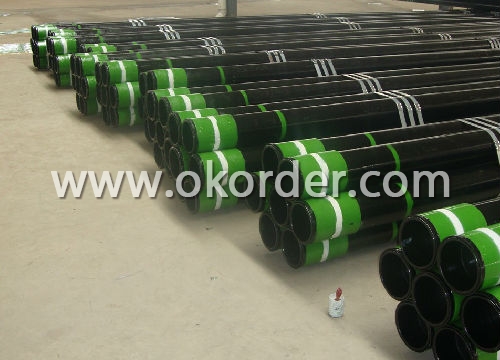
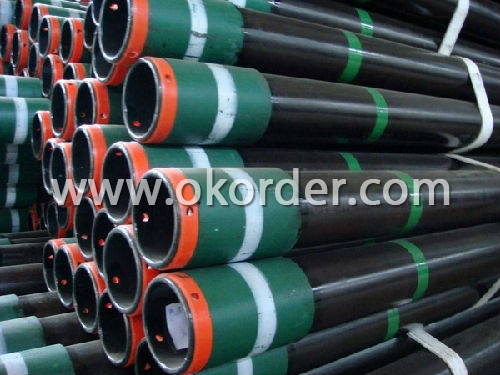
- Q: What are the different methods of pipe protection for steel pipes?
- There are several different methods of pipe protection for steel pipes, each serving a unique purpose and providing varying levels of protection. Some of the common methods include: 1. Coatings: Coatings are applied on the external surface of steel pipes to protect them from corrosion and other environmental factors. Coating materials can include various types of paints, epoxies, or polymers. These coatings create a barrier between the pipe surface and the surrounding environment, preventing the steel from coming into contact with corrosive elements. 2. Wrapping: Wrapping involves using a protective material, such as tape or shrink wrap, to cover the steel pipe. This method provides a physical barrier against moisture, chemicals, and other corrosive substances. Wrapping is often used in combination with coatings to enhance the overall protection. 3. Cathodic Protection: Cathodic protection is an electrochemical method used to protect steel pipes from corrosion. It involves connecting the steel pipe to a sacrificial anode, typically made of zinc or magnesium. The anode corrodes instead of the pipe, which helps to prevent the steel from deteriorating. This method is commonly used for buried or submerged pipelines. 4. Thermal Insulation: Thermal insulation is used to protect steel pipes from extreme temperatures. Insulating materials, such as foam or mineral wool, are applied around the pipe to minimize heat transfer. This method is particularly important for pipes carrying hot fluids or exposed to extreme weather conditions. 5. Vibration Dampening: Vibration can cause stress and fatigue on steel pipes, leading to potential damage. To protect against vibrations, various techniques can be employed, such as using vibration damping pads or installing supports and clamps. These methods help to absorb and dissipate the energy generated by vibrations, reducing the risk of pipe failure. 6. Concrete Coating: For pipelines installed underwater or in highly corrosive environments, concrete coating is often used. A layer of concrete or a cement-based mortar is applied to the steel pipe, providing both mechanical protection and resistance to corrosion. It is important to select the appropriate method of pipe protection based on the specific application, environmental conditions, and desired level of protection. Regular inspection and maintenance are also crucial to ensure the long-term integrity of steel pipes.
- Q: What does GALV mean in a steel tube?
- Steel pipe is not only used to transport fluid and powder solid, exchange heat energy, and manufacture mechanical parts and containers, but also is an economic steel. It can reduce weight and save 20 to 40% of metal by using steel pipe to make building structure, network frame, prop and mechanical support. Moreover, it can realize factory mechanization construction. Using steel pipe to manufacture road bridge can not only save steel, simplify construction, but also greatly reduce the area of coating protective layer, save investment and maintenance cost.
- Q: What are the different methods of pipe lining for steel pipes?
- Pipe lining for steel pipes can be done using various methods, each with its own unique features and benefits. These methods include: 1. Spray lining: A specially formulated coating is sprayed onto the inside of the steel pipe, creating a protective barrier against corrosion and chemical damage. Spray lining is a popular choice for smaller pipes due to its cost-effectiveness and quick installation. 2. Cured-in-place pipe lining (CIPP): This method involves inserting a flexible liner into the steel pipe and then curing it in place using steam or hot water. CIPP restores the pipe's structural integrity and is commonly used for larger pipes without the need for excavation. 3. Slip lining: By inserting a slightly smaller diameter pipe into the existing steel pipe and filling the space between them with cementitious material, slip lining rehabilitates pipes with minor defects and extends their lifespan. 4. Fold-and-form lining: A flexible liner is inserted into the steel pipe and expanded to its diameter using mechanical or hydraulic processes. The liner is then folded and formed to fit the pipe's contours before being cured in place. Fold-and-form lining is suitable for pipes with irregular shapes or bends. 5. Coating lining: A protective coating is applied to the inside surface of the steel pipe using spraying, brushing, or rolling methods. This coating acts as a barrier against corrosion and chemical damage and is commonly used for large pipes or those in harsh environments. Each method has its own advantages and disadvantages, and the selection will depend on factors such as pipe diameter, condition, budget, and project requirements. Consulting with a professional pipe lining contractor is crucial to determine the most suitable method for a specific steel pipe rehabilitation project.
- Q: How are steel pipes used in the construction of natural gas power plants?
- Steel pipes are used in the construction of natural gas power plants for various purposes such as transporting natural gas from the source to the plant, distributing gas within the facility, and carrying exhaust gases away from the plant. They are essential for maintaining a safe and efficient flow of natural gas throughout the power plant's infrastructure.
- Q: What are the different methods of threading steel pipes?
- There are several methods of threading steel pipes, including manual threading, machine threading, and dielectric threading. Manual threading involves using a manual pipe threader or a handheld die to create the threads on the pipe. Machine threading, on the other hand, utilizes power-driven machines that can thread multiple pipes simultaneously, increasing efficiency and accuracy. Dielectric threading is a specialized method that uses a high-frequency electrical current to generate threads on the pipe, which is commonly used for stainless steel pipes.
- Q: Can steel pipes be used for geothermal applications?
- Yes, steel pipes can be used for geothermal applications.
- Q: Are steel pipes suitable for underground mining applications?
- Yes, steel pipes are suitable for underground mining applications due to their durability, strength, and resistance to corrosion. They can withstand the harsh underground conditions, provide reliable transportation of fluids and materials, and are commonly used for ventilation systems, water supply, and ore extraction in mining operations.
- Q: Can steel pipes be used for conveying hazardous materials?
- Yes, steel pipes can be used for conveying hazardous materials. Steel pipes are known for their durability, strength, and resistance to corrosion, making them suitable for transporting various hazardous substances such as chemicals, gases, and liquids. Additionally, steel pipes can withstand high pressures and temperatures, ensuring the safe and efficient transportation of hazardous materials. However, it is important to ensure proper handling, maintenance, and adherence to safety regulations when using steel pipes for conveying hazardous materials.
- Q: What are the common methods for inspecting the condition of steel pipes?
- There are several common methods for inspecting the condition of steel pipes. These methods aim to identify any defects or potential issues that could affect the integrity of the pipes. 1. Visual Inspection: This involves a thorough visual examination of the pipes to identify any visible signs of damage such as corrosion, cracks, or leaks. Inspectors may use tools such as flashlights, mirrors, or borescopes to access hard-to-reach areas. 2. Ultrasonic Testing: This method uses high-frequency sound waves to detect defects within the steel pipes. A transducer is used to emit sound waves, and any disruptions or reflections in the waves can indicate potential issues such as cracks or thinning of the pipe walls. 3. Magnetic Particle Testing: This technique is primarily used to detect surface cracks or defects in steel pipes. A magnetic field is applied to the pipe, and fine iron particles are then applied to the surface. The particles will gather at any areas where there are surface defects, making them easily visible. 4. Eddy Current Testing: This non-destructive testing method is used to detect surface and near-surface defects in steel pipes. It involves passing an alternating current through a coil, which induces eddy currents in the pipe. Any disruptions or changes in the eddy currents can indicate defects such as corrosion or cracks. 5. Radiographic Testing: This method uses X-rays or gamma rays to inspect the internal structure of steel pipes. X-ray film or a digital detector is placed on one side of the pipe, while the X-ray source is placed on the other side. The rays penetrate the steel, and any irregularities or defects can be identified on the film or through digital imaging. 6. Dye Penetrant Inspection: This technique is used to detect surface-breaking defects in steel pipes. A dye penetrant is applied to the surface of the pipe, and after a specified period, a developer is used to draw out the dye from any defects. The dye will make the defects easily visible. These methods, either individually or in combination, provide a comprehensive inspection of steel pipes, ensuring their reliability and safety in various industries such as oil and gas, construction, and manufacturing.
- Q: Are steel pipes suitable for use in mining applications?
- Yes, steel pipes are highly suitable for use in mining applications. Steel pipes offer excellent durability, strength, and resistance to corrosion, making them ideal for transporting various materials, such as water, gases, and minerals, in mining operations. Additionally, steel pipes can withstand high pressure and extreme temperatures, ensuring their reliability and longevity in demanding mining environments.
1. Manufacturer Overview
| Location | Shanghai China |
| Year Established | 1999 |
| Annual Output Value | Above Thirty Million RMB |
| Main Markets | Main land;Middle East; Southeast Asia |
| Company Certifications | ISO 9001:2010;API 5L |
2. Manufacturer Certificates
| a) Certification Name | |
| Range | |
| Reference | |
| Validity Period |
3. Manufacturer Capability
| a) Trade Capacity | |
| Nearest Port | Baoshan |
| Export Percentage | 41% - 50% |
| No.of Employees in Trade Department | 300-500 People |
| Language Spoken: | English; Chinese |
| b) Factory Information | |
| Factory Size: | 30,000 square meters |
| No. of Production Lines | Above 10 |
| Contract Manufacturing | OEM Service Offered; Design Service Offered |
| Product Price Range | Average |
Send your message to us
BS 1387 Oil Casing and Casing Pipe APL SPEC 5CT Low Tolerance Best Quality BS Standard
- Loading Port:
- China Main Port
- Payment Terms:
- TT or LC
- Min Order Qty:
- 25 M.T. m.t.
- Supply Capability:
- 5000 Tons Per Month m.t./month
OKorder Service Pledge
OKorder Financial Service
Similar products
Hot products
Hot Searches
Related keywords
